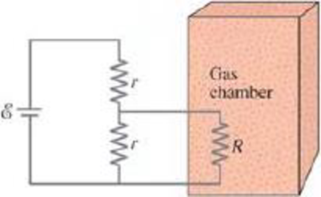
(III) You are designing a wire resistance heater to heat an enclosed volume of gas. For the apparatus to function properly, this heater must transfer heat to the gas at a very constant rate. While in operation, the resistance of the heater will always be close to the value R = R0, but may fluctuate slightly causing its resistance to vary a small amount ∆R (≪ R0). To maintain the heater at constant power, you design the circuit shown in Fig. 26–44, which includes two resistors, each of resistance r. Determine the value for r so that the heater power will remain constant even if its resistance R fluctuates by a small amount. [Hint: If ∆R ≪ R0, then

Want to see the full answer?
Check out a sample textbook solution
Chapter 26 Solutions
Physics for Scientists & Engineers, Volume 2 (Chapters 21-35)
Additional Science Textbook Solutions
College Physics: A Strategic Approach (3rd Edition)
Conceptual Integrated Science
The Cosmic Perspective (8th Edition)
An Introduction to Thermal Physics
College Physics
Life in the Universe (4th Edition)
- Explain why R=R0(1 + a?T) for the temperature variation of the resistance R of an object is not as accurate as P=P0(1 + a?T) which gives the temperature variation of resistivity P.arrow_forwardPower P0 = I0 V0 is delivered to a resistor of resistance R0. If the resistance is doubled (Rnew = 2R0) while the voltage is adjusted such that the current is constant, what are the ratios (a) Pnew/P0 and (b) Vnew/V0? If, instead, the resistance is held constant while Pnew = 2P0, what are the ratios (c) Vnew/V0, and (d) Inew/I0?arrow_forwardTwo resistors, one having a resistance of 840 kn, are connected in series to produce a total resistance of 0.430 MQ. (a) What is the value of the second resistance (in ko)? ΚΩ (b) What is unreasonable about this result? (c) Which assumptions are unreasonable or inconsistent? liarrow_forward
- -> موعد التسلیم اليوم، 01 م A two conductor street main AB , 500 meters in length is fed from both end at 250 volts. Load of 50A, 60A, 40A and 30A are tat distance of 100m , 250m ,250m, 350m, and 400 m from A ,respectively .lf the x-section of the conductors be 1 cm2 and specific resistance of the material of the conductor is 1.7x10-8 Q-m, determine the minimum consumer voltage. äbäi 1..arrow_forward(6) Suppose two electrical resistors with resistance R₁> 0 and R₂ > 0 are wired in parallel in a circuit: R₁ ww R₂ 1 1 1 + Then the combined resistance R, measured in ohms (2), is given by R R₁ R₂ ƏR ƏR (a) Find and after solving for R (e.g., R= ...). ƏR₁ ƏR₂ (b) Describe how an increase in R₁ with R₂ held constant will change R. (Will R increase or decrease?) (c) Describe how a decrease in R₂ with R₁ held constant will hange R. (Will R increase or decrease?)arrow_forward(a) Suppose two resistors are connected in parallel with resistances Rị and R2 measured in Ohms (N). The total resistance R is given by 1 1 1 R R1 R2 Suppose R1 is increasing at a rate of 1/4 2/s and R2 is increasing at a rate of 1/16 N/s. At what rate is R changing when R1 = 1/2 N and R2 = 1/4 N. (b) Car A is traveling North at a rate of 60 mi/hr, car B is traveling West at a rate of 45 mi/hr. The cars are on straight roads approaching an intersection point. At what rate is the distance between the cars changing when Car A is 3 miles from the intersection and Car B is 4 miles from the intersection.arrow_forward
- () THE FOLLOWING QUESTIONS ARE BASED ON THE INFORMATION GIVEN HERE, R3 ww The emf source, E = 2.1 V, of the circuit shown in the figure has negligible internal resistance. The resistors have resistances R = 1.91 and R = 5.9N. The capacitor has a capacitance C = 5.8 uF. R1 B) What is the charge Q on the capacitor in units of microcoulomb? Answer:arrow_forwardA cell of e.m.f. 1.5 V and internal resistance 1.0 N maintains a constant current of 0.5 A in an external circuit. When an electric charge of 2.0 C flows in the external circuit, calculate (a) (b) (c) the thermal energy dissipated from the cell. the energy dissipated from the external circuit. the total energy supplied by the cell. [Ans: 1.0 J, 2. 0 J, 3. 0 J ] 4-arrow_forward(a) In the given circuit, when the switch is OFF, the voltmeter reads 9 V and ammeter reads 0 A. However, when the switch is ON, the voltmeter reads 7V and ammeter reads 250 mA. Explain why the volmeter reading decreases when the switch is closed? Calculate the values of load resistance (R) and internal resistance (r). Aarrow_forward
- (!) THE FOLLOWING QUESTIONS ARE BASED ON THE INFORMATION GIVEN R2 HERE. The emf source, R1 C 3.5 V, of the circuit shown in the figure has negligible internal 1.4 Q and R2 = 4.5 Q. The resistance. The resistors have resistances R1 capacitor has a capacitance C = - 4.8 µF. A) Determine the time constant t, in units of microseconds, for charging the capacitor. Answer: B) What is the charge Q on the capacitor in units of microcoulomb? Ar wwwarrow_forwardA capacitor of capacitance C= 10 µF is connected to a resistance R = 2 2 and a battery of emf E= 5 V of negligible internal resistance. After 20 µs of completing the circuit, find C HH R WW E (a) power delivered by the battery (b) power dissipated as heat (c) rate of energy stored in the capacitorarrow_forwardIt's fairly common in electrical circuits for additional, undesirable resistances to occur because of factors such as dirty, corroded, or loose connections. Suppose that a device with resistance R normally dissipates power P, but due to an additional series resistance r, the total power is reduced to P'. We might, for example, detect this change because the battery powering our device ran down more slowly than normal. (a) Find the unknown resistance r in terms of P, P', and R. (b) Check that the units of your result make sense. (c) Check that your result makes sense in the special cases P' = P and P' = 0. (d) Suppose we redefine P' as the useful power dissipated in R. For example, this would be the change we would notice because a flashlight was dimmer. Find r.arrow_forward
 Physics for Scientists and Engineers, Technology ...PhysicsISBN:9781305116399Author:Raymond A. Serway, John W. JewettPublisher:Cengage Learning
Physics for Scientists and Engineers, Technology ...PhysicsISBN:9781305116399Author:Raymond A. Serway, John W. JewettPublisher:Cengage Learning College PhysicsPhysicsISBN:9781305952300Author:Raymond A. Serway, Chris VuillePublisher:Cengage Learning
College PhysicsPhysicsISBN:9781305952300Author:Raymond A. Serway, Chris VuillePublisher:Cengage Learning Principles of Physics: A Calculus-Based TextPhysicsISBN:9781133104261Author:Raymond A. Serway, John W. JewettPublisher:Cengage Learning
Principles of Physics: A Calculus-Based TextPhysicsISBN:9781133104261Author:Raymond A. Serway, John W. JewettPublisher:Cengage Learning College PhysicsPhysicsISBN:9781938168000Author:Paul Peter Urone, Roger HinrichsPublisher:OpenStax College
College PhysicsPhysicsISBN:9781938168000Author:Paul Peter Urone, Roger HinrichsPublisher:OpenStax College



